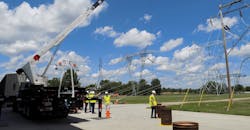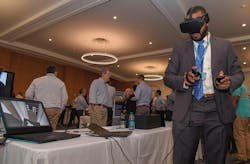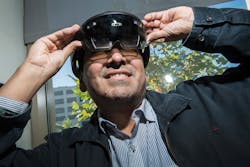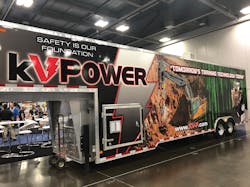In the early years of the line trade, training used to happen in one spot: the field. Today, electric utilities are constructing new training centers to give up-and-coming field workforce hands-on experience in a controlled environment.
For example, if you walk into the Transmission Training Center for American Electric Power (AEP) in Ohio, you won’t just see classrooms. You’ll also find actual indoor stations with digital and electromechanical relay protection as well as operational and simulated 69 kV to 765 kV lines with different structures represented on AEP’s system.
“From a hands-on perspective, all of the equipment that we’re using in the field is represented at our training facility,” said Marketta Franklin, director of learning and employee development at AEP.
On the 14-acre site, students can gain both live-line and barehand experience on an energized 345 kV line behind the training center. Franklin said from AEP’s perspective, learning is all about creating a safe place for learning.
“We make sure we have the right protective and insulated equipment and allow our employees to learn in a simulated environment,” she said.
Out in the field, workers have little to no margin for error, but at the training center, they can they can learn how to perform their duties in an environment that permits learning through trial and error. “If they make a mistake, they can get the coaching, guidance and mentoring they need,” Franklin said.
Here are ways that energy companies are training the next generation of linemen to meet tomorrow’s demands for power.
Pacific Gas & Electric: Infusing Technology into Training
Years ago, when it came to training linemen, utilities tried to replicate the field environments inside the classroom, said Rick Johnson, manager, electric curriculum development for Pacific Gas & Electric (PG&E). While this is still important, it’s also critical for the curriculum to adapt to workers’ technology needs, he said.
“Curriculum and field application exercises have to reach every employee to ensure they are in a position to learn,” Johnson said. “Learning must keep up with the conditions and environment facing today’s workforce.”
For example, PG&E uses technology such as iPads, virtual learning, Web-based training and self-paced structured learning courses to meet and be flexible with the learners’ needs. The utility also recently opened the doors to the hands-on transformer training lab within its Livermore Training Center.
“Today’s new employees want to know and understand the ‘why’ behind what they are doing or how it works,” Johnson said. “Our state-of-the-art transformer lab is an example of employees being able to see ‘what happens when I do this?’ in a safe environment.”
Before the opening of the new Evolution Substation facility, PG&E’s training scenarios were focused on equipment and theory. The new training center allows the utility to train its substation employees using real-world scenarios in a lifelike environment.
“The new substation facility will be used for apprentices and journeymen alike focusing on safety as the top priority and giving them the knowledge they need to be safe and successful in their jobs,” Johnson said.
During their apprenticeship program, apprentices receive more than 300 hours of classroom, hands-on and field instruction at the new substation facility. In early 2019, PG&E opened a fully functional, de-energized, two-bank distribution substation and attached learning facility. The Evolution Substation facility features multiple bus configurations, outdoor and metal clad circuit breakers, three-phase and single-phase transformers, GIS and the latest protection systems.
The classrooms/labs, which feature hands-on labs for the courses, are located in a building adjacent to the substation, and glass walls and doors open onto the substation.
“The focus for the classroom portion of the training was to create hands-on labs for the courses so the apprentices are not just sitting in a chair for many hours a day—they are actually able to get up and go practice what they just learned,” he said.
Within the training center, students attend such classes as Basic Electricity, Tower Climbing, Introduction to Schematics, Substation Grounding Fundamentals and Load Tap Changer Overview. During these courses, they will study in classrooms, which are actually connected to the classroom.
“The design of this facility is key,” he said. “By using large windows on the outside wall, this facility gives an instructor the ability to be teaching a class full of apprentices about a circuit breaker and then simply open the door and walk the class out to that circuit breaker. This is extremely beneficial in the learning process as they can actually see the piece of equipment, watch what it does and understand where and how it fits into the layout of the substation.”
Not only apprentices, but also journeymen, will spend time at the training center receiving any new or updated training due to new work methods or procedures, refresher training based upon business recommendations or needs and job-specific training based on departmental job openings. At the center, which can accommodate up to 300 students at a time, PG&E can train and test for commercial driving and crane certifications and administer the Employer Testing Program on-site.
Beyond the substation training area, the Livermore Electric Safety Academy (LESA) facility contains a 40-acre yard including energized and de-energized overhead and underground 12 kV and 21 kV fields for hands-on practice and skill assessments. This yard features more than 250 poles, several underground fields, transmission towers, a helicopter landing pad and paved space for driving and heavy equipment activities.
While apprentices learn their craft through hands-on activities at LESA and structured on-the-job training in the field, PG&E also offers educational experiences in multiple delivery formats. For example, most of the programs include instructor-led, e-learning, self-study, virtual learning and blended-learning components.
PG&E focuses on training not only its apprentices, but also its journeymen linemen on the latest technology as it maintains and upgrades its system.
“Line workers should also understand how grid technology works,” Johnson said. “Equipment is constantly upgraded and updated to meet the needs of a changing world.”
Con Edison: Transforming Learning
Like PG&E, Con Edison is taking a multi-dimensional approach to training its employees. The company opened the doors to its Learning Center 25 years ago, and today, the center offers both traditional and online training modules.
Over the last few years, the company has implemented an initiative to transform the company’s learning platforms. By evaluating new digital tools, the utility aims to increase engagement and knowledge retention while offering effective training solutions to its employees at any time, pace or place.
“Con Edison fosters a culture of learning by providing employees with the latest advancements in training,” said Keith Scully, manager, process and technology group. “We feel it is critical to continue to attract, train and retain talent to meet the demands of a changing regulatory, industry and technological landscape.”
By looking at similar training initiatives in other industries, a team at Con Edison realized the value of virtual reality as a training tool due to its ability to reduce the time it takes a trainee to become proficient.
The utility created a Training Effectiveness Committee to promote the program, receive feedback and define the best topics for virtual reality training. Over the past 18 months, the committee has focused on virtual reality modules. By performing a task analysis for each job title, Con Edison was able to address immediate training needs for its workforce.
Con Edison’s subject matter experts then worked with a consultant and a certified instructional designer to create training modules. Each module begins with a storyboard, which lays out the road map for the module including possible safety concerns, required personal protective equipment, a scripted scenario and randomly activated hazards and other associated fails along with a comprehensive assessment.
“The first training module took a few months to complete, but now we create new modules in six to 10 weeks depending on their complexity,” Scully said. “Our objective is to get trainees to reach proficiency faster. That means we need to more effectively train them about how to make the right choices and safely accomplish the tasks they will be asked to do in the field.”
“With virtual reality training, you don’t have to worry about slips, trips and falls and other potential hazards associated with electric and gas installations,” Scully said. “Virtual reality provides the trainees to use a self-paced tool that allows them to make mistakes safely as they learn. It is not a replacement for field training, but when the trainees go into the field to practice what they have learned, they’ve already done it virtually.”
Rather than having to travel to different locations in the field, access available equipment and contend with varying weather conditions, the virtual reality training allows trainees to experience six to eight different modules in a day in the safety of a classroom. “Virtual reality training immerses employees in the task being performed,” Scully said. “They are engaged physically and mentally.”
Because the students are training in a controlled, safe environment, they won’t get injured even if they fail a certain part of the module.
“A lot of the work we do is in hazardous situations,” he said. “This tests employees’ knowledge of safety procedures and procedural adherence in a safe environment.”
To engage in the virtual reality training, the trainees wear a headset, which wraps around the head so even peripheral vision is immersed in a three-dimensional world. By holding a control in each hand, trainees stand in front of a big-screen television, where a module is displayed for the class to view.
After completing a brief tutorial on how to use the controllers, the trainee is asked to accomplish specific tasks. Trainees begin with choosing the correct PPE, then conduct a thorough inspection and complete required tasks.
“Trainees will encounter a few virtual surprises along the way — from swaying trees, flocks of birds, loose handrails and missing basement stairs to curious pets, and the occasional scurrying rat,” Scully said. “This prepares trainees to master their tasks safely while experiencing common field conditions designed to break their concentration. The goal is to put them in a real-life situation to practice what they have learned in a completely safe and self-paced evironment.”
Because many of the trainees are familiar with gaming and already comfortable with the technology used in the training, there is little to no learning curve in the training itself.
“The equipment that we use is very intuitive, headsets are lightweight and the controllers are ergonomic,” he said. “Con Edison’s virtual reality training program is one of the most popular learning experiences among employees.”
Currently, Con Edison is working on an augmented reality module, which will serve as a training tool and a job aid of the future.
“We’re looking at developing more complex modules to push the envelope with training challenges even further,” he said. “Our next step is developing augmented reality tools that can be used both for training and in the field as a job aid. We are also testing recognition software to help employees in the field identify equipment and its related specifications and procedures.”
KV Power: Focus on Safe Driving
Before bringing new employees on board, KV Power is first vetting its potential recruits with its driving simulators. Bryan Hoffman, the owner of the company, first saw the technology from CM Labs at ConExpo two years ago.
After traveling to Dallas to try out the product at a local union hall, Hoffman decided to invest in the technology for his own company. Brian Griffis, vice president of safety and health, said the simulator is often used in the aircraft industry, and the management team thought it could also be used to improve safety in the utility market as well.
“We are only as good as our people, and if we put qualified people in the field, they will be able to get home every night,” Griffis said. “Also, everyone in the industry must show their training records, and there’s no other better way to make sure you are putting your trained people on customers’ property.”
KV Power now has two custom trailers with the driving simulators, which the company can drive from one location to another. In the future, the company plans to take the trailers throughout the Southwest and work with competitors and other industries beyond just construction for training.
“If you are wondering what skill sets your people have, this will prove it,” Griffis said. “You can put them in the seat and score it for them.”
The technology is especially helpful for evaluating potential employees once they have earned their commercial driver’s license. Once they apply for a position with the company, KV Power can test their driving skills on a wide range of equipment without tying up valuable pieces of equipment.
“If someone is not a good operator, it’s a bad situation for everyone,” he said. “Before taking their word that they have 10 years of experience and hiring them on, you can find out if they can perform.”
KV Power, which has 425 employees, can then train new employees, track manhours and break down how much time an individual is spending on training on a new piece of equipment. For example, the company can simulate the different pieces of equipment on a particular job.
“On the crane side, if we have a critical lift coming up in a week, we can put the parameters on it, and the crane operators can sit in the seat and practice the lift before they get into the field,” Griffis said.
In addition to the virtual simulators, KV Power is also considering investing in a new training lab with different modules of control panels.
“The industry has been doing the same things for a long time, and we are all pulling from the same labor pool,” Hoffman said. “The key to moving ahead is through organic growth and the right training.”
Sidebar: Best Practices in Workforce Training
Energy companies and contractors nationwide are helping their linemen to stay safe in the field through training and development. Here are some ways American Electric Power Ohio is boosting the effectiveness of its training programs.
1. Mix your classes from across your service territories. AEP brings its transmission line mechanics, station and service electricians, power and control technicians and engineers together in one centralized location for training. “It is a good opportunity for employees to network with one another and discuss and identify deficiencies or gaps in our standards,” said Marketta Franklin, director of employee development and training for AEP.
2. Use your training center as a testing ground. Before rolling out a new device in the field, AEP does the proof of concept for it at the training center. “When we are introducing a new product out in the field, we bring it into the training center first,” Franklin said.
3. Provide a balanced hybrid of learning focusing on skills, knowledge, and behaviors. AEP incorporates both instructional and dynamic hands on learning. “Hands on learning on allows our students to get the full grasp of the end-to-end process,” Franklin said.
4. Encourage your employees to get involved. AEP has a culture within its organization, which encourages its employees to not only bring up an issue, but also be part of working together to find the solution. “We don’t do a lot of hand-overs to the training group to solve,” Franklin said. “We invite them to come up with innovative ideas and be part of a committee to create a prototype, test it and implement it. It’s a collaboration between the field and the training center or standards group.”
5. Offer a variety of infrastructure on your training grounds. Behind AEP’s Transmission Training Center, AEP has every type of infrastructure that the linemen work on—from lattice towers to tubular structure towers to wood poles to distribution underbuild as well as Live 138kV and 345kV lines.
Sidebar: Spotlight on Virtual Reality Training
Since Con Edison launched its virtual reality program, the company has created safety protocols on simulated gas and electric installations including:
• Underground electric service, single-family, 100 A meter pan inspection
• Low-pressure gas service, single-family, Class 250-meter inspection
• Underground electric service, residential, single-phase Trans S meter cabinet inspection
• Underground electric service, commercial, three-phase, 120/208v Trans S meter cabinet inspection
• Underground electric service, commercial, three phase 277/480v Trans S Meter cabinet inspection
• High-pressure gas service, commercial, 3M rotary meter inspection
• Low-pressure gas service, twin set meter inspection
• Sealing secondary cable ends
• Short and seal primary cable ends
• Underground electric service, multi-bank meter installation inspection.





